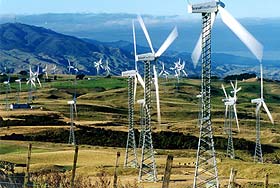 V47-660 kW wind turbines for the project.
V47-660 kW wind turbines for the project.Electricity Generation from Wind Power In New Zealand
Tararua Wind Power, a wholly owned subsidiary of Central Power Limited,
developed a wind power project on the Tararua Ranges, near Palmerston North, New
Zealand.
Vestas-Danish Wind Technology A/S, the largest manufacturer of wind
generation technology in the world, supplied and installed 48 Vestas Model V47-660 kW wind turbines for the project.
V47-660 kW wind turbines for the project.
Note: Central Power Limited was forced to sell its generation business when the NZ Government changed legislation and the wind farm became the property of Meridian Energy. Unfortunately that company has not published any data on the Tararua Wind Farm.
There is also now a wind
farm to the North of the Gorge called Te Apiti and owned by Meridian
Energy. It has a planned capacity of 90MW and will be the largest wind
farm in the southern hemisphere.
Project Location - of the Southern wind farm
The wind farm is located in the Tararua Ranges south of the Manawatu
Gorge, see map below. The site is located on 700 hectares of private land on a
ridge of rolling hills which is presently used for sheep and beef farming. It is
4 kilometres south-west of Ashhurst, 5 kilometres west of Woodville, 11
kilometres east of Palmerston North and 10 kilometres north-west of Pahiatua.
This area of the Tararua Ranges is recognized as one of the best sites for a
wind farm in New Zealand and ranks with the best sites in the world, The average
wind speed on the site is approximately 35 kilometres per hour with the wind
speed above the minimum turbine operating level for more than 85% of the time.
Project Description
The site has the potential to accommodate up to 103, 7-660 kw turbines with
a generating capacity of approximately 67 Megawatts. Development of the site
will be done in stages. The initial development of 31.7 Megawatts will require
48 V47-660 kW turbines. Output from the project will be fed into the Central
Power system with this initial development providing approximately 20% of
Central Power's annual energy requirements. This is equivalent to the
electricity used by 15,000 homes.
Each wind turbine is mounted on
a steel lattice tower, similar to a power pylon. Each turbine will have three
blades with each blade having a length of 23.5 metres. The blades have full
feathering ability, and will adjust themselves to maintain a relatively constant
speed. The turbine is also able to turn on the tower to capture winds from
different directions.
The output from each turbine is taken by underground cable to a substation and
switching yard in the middle of the site. From there it is taken by overhead
line to the Central Power system.
Environmental Effects
The environmental effects of the project are considered to be minor. To
capture the wind effectively turbines do need to be sited on ridge lines where
they are visible. However the use of lattice towers and correct color selection minimizes
the impact on the landscape. A number of visual simulations have been prepared
showing the expected visual impact from various sites.
A detailed noise study has been
completed and concludes that because the project is sited well away from
populated areas there will be negligible effects from noise Agreement has been
reached with telecommunications facility owners on the site for the location of
individual turbines to ensure there is no interference with existing services
provided from the site
The site has no special
significance with respect to cultural, ecological, spiritual or historical
aspects.
Internationally wind farms are recognized as potentially the most
environmentally friendly power generation technology commercially available
today Wind farms do not create harmful gases that are expelled into the
atmosphere and do not cause the major and irreversible changes to the landscape
that hydro developments can.
Economic Effects
The very good wind resource that exists on site means that the cost of
electricity generated from the project is similar to Central Power's present
delivered cost of power.
Project Timetable
Tararua Wind Power applied to the Tararua District Council for a resource
consent for the project in November 1995. Resource Management Act consent was
granted in February 1996. Notice to Proceed for the project was issued in
February 1998 and the first wind turbines were on the site in October 1998.
The Future
Currently GE in the US are developing a 3.6M.W
unit. It's big!
However most solutions bring their own problems.